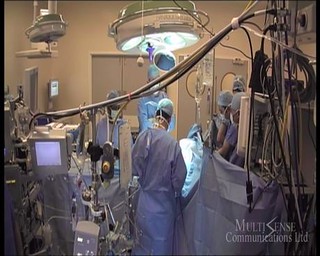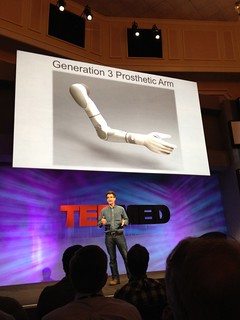With the continuing
controversy revolving around the balky launch of healthcare.gov, suddenly
online medical sites have suddenly taken center stage. However, what the public
is largely unaware of is the fact that the medical industry is hugely invested
in the Internet. Not only is everything from medical advice to products
and services available online, but even advances like telesurgery and
telediagnosis are becoming more prevalent. This article probes the telemedicine
revolution that is occurring as we speak. The medical industry has embraced the
Internet for everything from social networking to robotic surgery. So read on
and learn when your next remote medical office visit will take place.
| Telemedicine in Action - Open Heart Surgery on Vimeo (Photo credit: Andy G) |
When it comes to technology,
the medical profession is no slouch.
During the course of the past few decades all manners of high-tech
diagnostic tools, surgical suites and bionic limbs have become commonplace in
doctor’s offices and hospitals. But what
most people are unaware of is the fact that there are a number of revolutionary
new technologies that are going to forever change the very way that a visit to
the doctor or ER takes place.
Is There a Virtual Doctor in the House?
The age of the virtual doctor
has already arrived across the US.
Invented by NASA for use on the International Space Station,
telemedicine has found its way into a number of hospitals, as well as
online. Telemedicine connects patients
with physicians via the Internet, allowing them to skip a trip to the doctor’s
office while saving money at the same time.
Several online businesses have created models where patients can
teleconsult with a physician, including MDLive, while others, such as iRobot
have created telepresence robots that allow physicians to interface with
patients around the world. Some of the more sophisticated models even allow a
surgeon to perform surgery by remote control.
| English: Logo for iRobot (Photo credit: Wikipedia) |
While some of these devices
are designed to be monitored by the user, others such as products made by
BodyTel offer those with chronic illnesses Bluetooth enabled devices that automatically
send readings to the user’s doctor. Capable of monitoring and reporting on
everything from blood glucose levels to blood pressure, this technology
represents a whole new level of health care.
New Wearable Devices Keep Tabs on Your Vitals
| Dean Kamen at TEDMED2011 (Photo credit: Klick Pharma) |
That doesn’t mean that this
technology won’t eventually be miniaturized to the point that it will fit
unobtrusively into a hairband or ball cap.
In fact, at least other medical device pioneer has created the prototype
for a blood glucose monitor that resides in a contact lens. Google recently announces that the contact
lens it is designing will measure glucose in tears on a continuous basis using
a wireless chip and miniature glucose sensor.
Once available, the device will make a lot of diabetics happy, since the
predominant method of testing blood glucose levels involves pricking the
finger.
Bionic Insole – An Athlete's Best Friend
At the other end of the
spectrum, Moticon has introduced the world’s first computerized insole that can
be used in any shoe to measure motion for patients and athletes. The bionic insole comes complete with firmware
that communicates with a user’s computer via a USB radio stick. In 2010, Moticon was awarded the
International Innovation Award for this product. (Dr. Scholl’s move over.)
Speaking of bionics, just
before Thanksgiving 2013, Mick Ebeling returned home from Sudan's Nuba
Mountains where he set up what is probably the world's first 3D-printing
prosthetic lab and
training facility. Called Project Daniel, the effort was begun by one man who
learned about a 14-year old double amputee named Daniel. Flying to Sudan with a 3D printer, Mick not
only created prosthetic arms and hands for Daniel, but he vowed to teach the
locals how to help many of the 50,000 Sudanese who have lost limbs from the
ongoing conflict in the area. (See the
video at http://www.notimpossiblelabs.com/)
Medical Social Networking Comes of Age
 Of course the internet isn’t
only used today by patients. It is also
being increasingly employed by doctors as well.
In fact, there is a prominent new social network for the medical industry
called MedMasters.com. This network
connects members of the medical community by providing a searchable database of
doctors, nurses, medical IT providers, medical recruiters and pharmaceutical
sales representatives that is as easy as point and click. Useful for everyone from healthcare providers
to people seeking to enter the healthcare industry, this is the interactive go to social network
for all things medical. Best of all,
joining the network is free and easy.
Of course the internet isn’t
only used today by patients. It is also
being increasingly employed by doctors as well.
In fact, there is a prominent new social network for the medical industry
called MedMasters.com. This network
connects members of the medical community by providing a searchable database of
doctors, nurses, medical IT providers, medical recruiters and pharmaceutical
sales representatives that is as easy as point and click. Useful for everyone from healthcare providers
to people seeking to enter the healthcare industry, this is the interactive go to social network
for all things medical. Best of all,
joining the network is free and easy.
Electronic Aspirin Can Cure Headaches
While many of these cutting
edge technologies concern themselves with big ticket issues, there are some
that aim to alleviate the small problems that the public faces every day. For migraine
sufferers help is on the way. For many years, doctors have associated the most chronic
forms of headache with the sphenopalatine ganglion (SPG), a facial nerve bundle. Until recently there were treatments that
provided long term SPG relief. A new technology under clinical testing at Autonomic Technologies, Inc., (Redwood City, CA) is an
implantable tool for blocking SPG signals at the first sign of a headache. The
system consists of a small nerve stimulating device that can be operated by
remote control whenever a patient senses the onset of a headache. The resulting
signals stimulate the SPG nerves and block the pain-causing neurotransmitters.
 Bear in mind
that these are but a few of the latest medical technologies that are being
developed to help people live longer, healthier lives. Because the one thing you can say about
taking your medicine online is that, it does not leave a bad taste in your
mouth. Link to our research for the show and this article are available on the show notes page of this blog. Thanks for
spending your time with us, until next time, Keep Working The Web!
Bear in mind
that these are but a few of the latest medical technologies that are being
developed to help people live longer, healthier lives. Because the one thing you can say about
taking your medicine online is that, it does not leave a bad taste in your
mouth. Link to our research for the show and this article are available on the show notes page of this blog. Thanks for
spending your time with us, until next time, Keep Working The Web! This article explains the how the medical industry has embraced the internet as an asset to
improve medicine. Included in this discussion are the emerging technology
advances in Telemedicine, Telediagnosis, Robotic Surgery, communications and even
medical social networking. If you want to learn even more on this subject, tune
in to our “Working the Web to Win” radio
show on Blog Talk Radio. If you found this article to be useful, share it
with your friends and co-workers.
This article explains the how the medical industry has embraced the internet as an asset to
improve medicine. Included in this discussion are the emerging technology
advances in Telemedicine, Telediagnosis, Robotic Surgery, communications and even
medical social networking. If you want to learn even more on this subject, tune
in to our “Working the Web to Win” radio
show on Blog Talk Radio. If you found this article to be useful, share it
with your friends and co-workers.
If
you'd like a free copy of our eBook, "Internet Marketing Tips for the
21st Century," please fill in the form below and we'll email it to you.
Your information is always kept private and is never sold.
Since 1995, Carl Weiss has been helping clients succeed online. He owns and operates several online marketing businesses, including Working the Web to Win and Jacksonville Video Production. He also co-hosts the weekly radio show, "Working the Web to Win," every Tuesday at 4 p.m. Eastern on BlogTalkRadio.com.














This is the success of Digital Media Marketing and social media agencies where even disabled can do anything with the help of Internet..
ReplyDeletewith all these advancements in technology, we're going to be living in an age with devices like those on Star Trek soon enough.
ReplyDelete